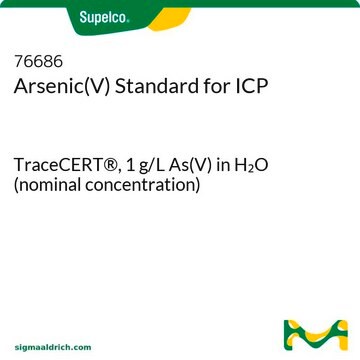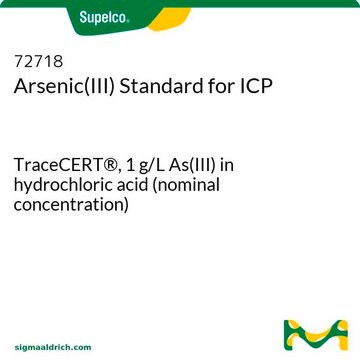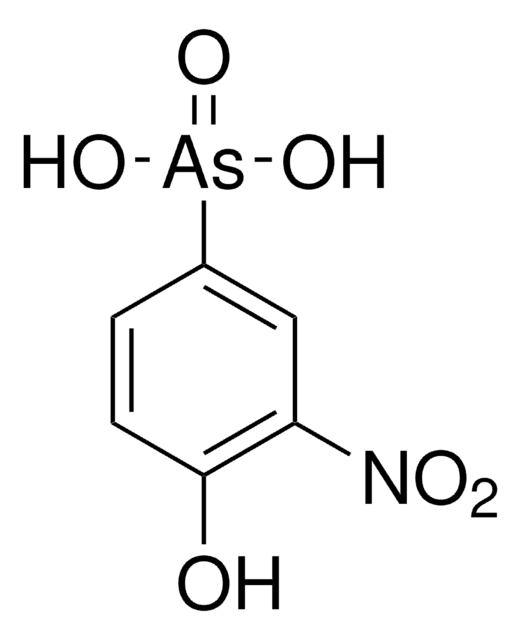11093
Arsenobetaine
purum p.a., ≥95.0% (NMR)
Synonym(s):
2-(Trimethylarsonio)acetate
Sign Into View Organizational & Contract Pricing
All Photos(1)
About This Item
Empirical Formula (Hill Notation):
C5H11AsO2
CAS Number:
Molecular Weight:
178.06
Beilstein:
3933180
MDL number:
UNSPSC Code:
12352100
PubChem Substance ID:
NACRES:
NA.22
Recommended Products
grade
purum p.a.
Quality Level
Assay
≥95.0% (NMR)
form
solid
SMILES string
C[As+](C)(C)CC([O-])=O
InChI
1S/C5H11AsO2/c1-6(2,3)4-5(7)8/h4H2,1-3H3
InChI key
SPTHHTGLGVZZRH-UHFFFAOYSA-N
Looking for similar products? Visit Product Comparison Guide
Application
Arsenobetaine has been used to investigate the biochemical response of mice (Mus musculus) to inorganic arsenic exposure using liver as the target organ.
Packaging
Bottomless glass bottle. Contents are inside inserted fused cone.
Signal Word
Danger
Hazard Statements
Precautionary Statements
Hazard Classifications
Acute Tox. 3 Inhalation - Acute Tox. 3 Oral - Aquatic Acute 1 - Aquatic Chronic 1
Storage Class Code
6.1C - Combustible acute toxic Cat.3 / toxic compounds or compounds which causing chronic effects
WGK
WGK 3
Flash Point(F)
Not applicable
Flash Point(C)
Not applicable
Personal Protective Equipment
dust mask type N95 (US), Eyeshields, Gloves
Choose from one of the most recent versions:
Already Own This Product?
Find documentation for the products that you have recently purchased in the Document Library.
Customers Also Viewed
M A García-Sevillano et al.
Metallomics : integrated biometal science, 5(12), 1644-1655 (2013-10-05)
Organic and inorganic mass spectrometries were used to investigate the biochemical response of mice (Mus musculus) to inorganic arsenic exposure using liver as the target organ. The toxicological effects of trivalent inorganic arsenic after oral administration (3 mg kg(-1) body
Marisa H Sobel et al.
Journal of the American Heart Association, 9(4), e015658-e015658 (2020-02-19)
Background Arsenic-related cardiovascular effects at exposure levels below the US Environmental Protection Agency's standard of 10 μg/L are unclear. For these populations, food, especially rice, is a major source of exposure. We investigated associations of rice intake, a marker of arsenic
K J Whaley-Martin et al.
Talanta, 88, 187-192 (2012-01-24)
Arsenic is ubiquitous in the tissues of marine organisms and in uncontaminated environments it is dominantly present as the highly soluble and easily extractable non-toxic arsenical, arsenobetaine. However in contaminated environments, higher proportions of inorganic arsenic, which is much less
Miranda R Jones et al.
Epidemiology (Cambridge, Mass.), 22(2), 153-161 (2011-01-06)
High chronic exposure to inorganic arsenic may contribute to the development of hypertension. Limited information is available, however, on the association of low to moderate exposure to inorganic arsenic with blood pressure levels and hypertension. We investigated the association of
Jörg Feldmann et al.
Analytical and bioanalytical chemistry, 399(5), 1735-1741 (2010-10-26)
In this opinion paper the toxicokinetic behaviour of arsenosugars is reviewed and compared with that of inorganic arsenic and arsenobetaine. It is concluded that the arsenosugars are similar to inorganic arsenic in terms of metabolite formation and tissue accumulation. As
Our team of scientists has experience in all areas of research including Life Science, Material Science, Chemical Synthesis, Chromatography, Analytical and many others.
Contact Technical Service












